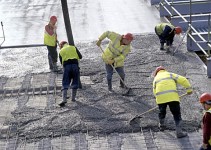Cadastral surveys are carried out before all major construction and development projects. During this process, a cadastral surveyor performs a mixture of field work and historical research to find and mark the boundaries and points of interest on a property. These markings can then be used for constructing buildings, fences, infrastructure, utilities, landscaping and more.
Surveyors use dozens of different types of marks, depending on which features are being indicated. Deciphering the meaning of these markings may be a challenge. To help out, we’re going to discuss cadastral surveying markers in more detail, and look at some of the different types of markings that are in use today.
Cadastral Survey Marks
Cadastral survey marks is a general term that refers to the marks used by surveyors. These marks come in dozens of shapes and sizes, and they may be used to indicate the position of things like:
- Reference marks
- Property corners and boundary lines
- Major vegetation or landmarks such as trees and boulders
- Construction set out points
- Utility runs
- Easements and other restrictions
- Other features
It’s important to note that the phrase “cadastral survey marks” usually refers to temporary markers. These are often intended to be removed as the construction process progresses.
Permanent Survey Marks
Where cadastral survey marks are temporary and designed to be removed, permanent survey marks are designed to persist for decades. These marks serve as a permanent reference point that can be used to locate other points of interest on a parcel of land.
For instance, a survey plan may mark the exact GPS coordinates of a permanent survey mark. Using that mark, the surveyor can then locate the corners of a property. The corners can then be transposed onto the new survey plan, and features such as structures, vegetation, fences and retaining walls can then be marked on the plan.
Like the name suggests, permanent markers are not intended to be removed during construction work. In some Australian states you may need to obtain permission from the local council to move or remove a permanent survey marker.
You should always engage a surveyor before undertaking any type of project that may disturb survey markers. The surveyor can assess the area and help you move or alter marks that may be affected by your project.
Boundary Marks
Boundary marks are subset of cadastral survey marks that are specifically used to identify the corners of a parcel of land. In Australia, boundary markers are usually large wooden pegs that have been painted white. Pegs are hammered into the ground at the corners of the property. The tops of pegs may be painted a contrasting colour to improve visibility and clarify the marker’s intention.
Boundary markers are some of the most common survey marks. They’re often found on vacant land or properties that are undergoing construction projects, neighbourly disputes or other works.
Types of Markers Used
Temporary and permanent survey marks take many different forms. While there is no standardisation in the industry, most surveying companies use similar markings to indicate property boundaries and points of interest. It’s common for surveyors to use markers such as:
- Wooden pegs that have been painted white. Pegs may be painted an additional colour to clarify the intention of the marker. The peg may also include lettering or numbering that corresponds with the survey plan.
- Plastic pegs which consist of an iron stake with a colour-coded plastic cap. These are often used as an alternative to wooden pegs, depending on the condition of the property.
- Concrete nails may be driven into hard surfaces such as roads and gutters as a type of permanent survey marker. During construction work, these markers are often clarified with spray paint and numbering.
- Brass plaques that are fixed into the ground using concrete. Another form of permanent survey mark (often used by official government bodies), brass plaques have details stamped into the metal to indicate the marker’s purpose.
- Coloured ribbon tape may be fixed to trees, fences, stumps and other landmarks using screws or nails. Ribbon tape is highly visible and can be used to mark corners and general points of interest.
Can I Move Survey Marks?
You should never move, damage or disturb survey marks. Survey marks constitute an official point of reference that has been recorded on survey plans that are submitted to government sources. Moving survey marks can affect property values, cause disputes and affect the placement of things like utilities runs. This may have a large impact on a construction project, and you could face serious penalties.
Cadastral survey markers that are intended to be moved should only be altered with permission from your surveyor. It’s best to leave cadastral markers where they are until a surveyor has used them to set out the construction work you are planning.
Permanent survey markers should never be interfered with. Depending on where you live, you may need to speak to your local council or a town planner if a permanent marker will be affected by your work. Since these marks are often found in public infrastructure (such as roads and gutters), most construction projects shouldn’t affect the location of permanent markers.

